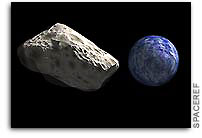Rep. Rohrabacher Requests Hearing To Assess Near Earth Objects Threat

Calls Current Program “Woefully Inadequate”
Washington, DC-June 23, 2007- Rep. Rohrabacher sent a letter to Rep. Mark Udall, Chairman of the Subcommittee on Space and Aeronautics, requesting a hearing to examine the United States’ ability to track Near Earth Objects (NEOs) that potentially pose a significant threat to the planet. A March 2007 report released by NASA restated the goals of the current detection program, known as Spaceguard, and described the possible destruction caused if an NEO were to collide with the earth. “At this time,” writes Rohrabacher, “our ability to discover and track such objects is woefully inadequate.”
“While progress has been made in detecting large numbers of NEOs that will not hit the Earth, we still do not have in place a system that adequately deals with the actual detection of an NEO on a scheduled collision course with the planet,” says Rohrabacher. In 2005, Rohrabacher sponsored the George E. Brown Jr. Near Earth Object Survey Act (HR 1022) which would increase NASA’s program by requiring 90% of NEOs 140 meters and larger to be cataloged within 15 years. During testimony earlier this year, NASA Administrator Michael Griffin admitted there is no funding available to increase resources for NEO detection, despite passage of HR 1022 under the 2005 NASA Authorization Act. In addition, the Arecibo Radio Telescope, a key resource in NEO detection, is scheduled to be shut down by 2011.
“We need to have a fully funded program that concentrates on identifying threats from space and a response system in place to address that threat once it is identified,” says Rohrabacher. Mr. Rohrabacher is a member of the Science and Technology Subcommittee on Space and Aeronautics and the Subcommittee on Investigations and Oversight.
###
ATTACHMENT
June 20, 2007
Hon. Mark Udall
Chairman, Subcommittee on Space & Aeronautics
Committee on Science and Technology
B-374 Rayburn House Office Building
INSIDE MAIL
Dear Mr. Chairman:
Near Earth Objects (NEOs) including asteroids and comets are often ignored, yet pose a significant threat to our planet. According to a March 2007 NASA report entitled “Near Earth Object Survey and Deflection Analysis of Alternatives,” NASA predicts that there are 20,000 objects, each with the potential energy of 100 megatons of TNT or more, that can be considered “potentially dangerous objects.” A 100 megaton collision event is predicted to cause a minimum of 50,000 fatalities.
At this time our ability to discover and track such objects is woefully inadequate. NASA’s current program, known as Spaceguard, has a goal of discovering 90% of NEOs with a 75,000 megaton potential (estimated to cause more than a billion fatalities). If this program is successful, it is estimated that only 35% of the 100 megaton objects will be found.
As a result in 2005 I sponsored H.R. 1022, the “George E. Brown Jr. Near-Earth Object Survey Act” which would substantially increase the program by requiring 90% of NEOs 140 meters and larger be cataloged within 15 years. The bill was passed as part of the 2005 NASA Authorization Act.
However, in a hearing earlier this year NASA Administrator Michael Griffin testified that while he is concerned about the situation, NASA has no funds available to carry out a more extensive program than Spaceguard. In addition, the Arecibo Radio Telescope, a key resource needed to track NEOs, is on schedule to be shut down by 2011.
Taking the aforementioned factors into consideration, I respectfully request the Space and Aeronautics Subcommittee convene a hearing for the following purposes:
- To review the status of the Spaceguard program in terms of its ability to meet the goals of the Survey Act,
- To explore the impact the closing of Arecibo will have on current and future NEO programs,
- To ascertain what other resources may be brought to bear to achieve the object of the Survey Act,
- To determine future actions necessary to implement the Survey Act.
Thank you for your consideration of this request and you personal attention to this matter.
Sincerely,
Dana Rohrabacher
Member of Congress
CC: Congressman Ralph Hall,
Congressman Bart Gordon,
Congressman Tom Feeney.









